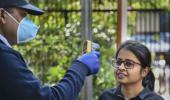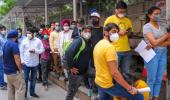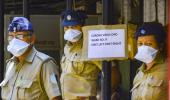'If we cannot handle an epidemic of that strata, (causing that kind) of excessive calamity, then we really have to prevent it.'
'If we become complacent in even preventing it, then we are in for a disaster.'

Dr Trupti Gilada is an infectious disease specialist at the Unison Medicare and Research Centre, south Mumbai. She consults at the Prince Aly Khan hospital at south central Mumbai.
She trained at the KEM and Nair hospitals in Mumbai and spent three years doing her fellowship in infectious disease at Harvard. Dr Gilada has won a global award for HIV research.
"We aren't extremely well prepared for the epidemic. We are only saying that because we're still at (low fatality) numbers," Dr Gilada tells Rediff.com's Vaihayasi Pande Daniel about COVID-19 and the necessary steps required in India to prevent its spread. The first of a two-part interview:
What exactly is the community spread of a viral pandemic like COVID-19? Has India reached that stage yet?
The coronavirus epidemic, or for that matter any epidemic, that spreads from one country to the other, goes through different stages.
Stage One of the epidemic is when the cases are found only among people who travelled to that country (that had the viral outbreak).
Stage Two is when we find cases amongst contacts of these travellers.
And Stage Three is when the disease has come into the community, which means that it's not just in the travellers or their contacts. It's also now in the general community, which means that now, if we were to screen only those who were travellers or contacts, we would miss a lot of cases.
So at this point, we (in India) are just between (Stages) Two and Three, because all the recent cases, that we have found, have only been in travellers or in their contacts. But we also know that what we find is probably just part of the cases.
Let me just backtrack to again understand the definition of community spread. If there's a traveller, and he has given it to his family, so when the family gives it to their neighbour, that still is not community spread?
So once the neighbour has acquired it, it is community spread.
But I am told the community spread means when some case presents itself, where the person doesn't know where he's got it from. So you're saying it's both?
That's true.
In a lot of cases, you will be able to just go back and see that: 'Oh so this person got it from the neighbour's house and the neighbour was in touch with this person'.
But once we skip, when three or four steps have gone (missing), and there is no way to go and say where did that happen from?
And once that happens, that is the point where -- if you've seen the graph of any epidemic -- that is the time when the graph starts rising ie when it's community spread.
So you are saying in India now we are between Stage Two and Stage Three?
We are. Even now, they have always been able to track down the contacts and who these cases have been in touch with.
But we know that is not going to be like this for another one week. We know it is going to spill out into the community a bit.
But nobody's talking about community spread yet?
The whole thing of social distancing is because we anticipate community spread.
If we were not anticipating community spread, there was no need of social distancing. Then just screening travellers and quarantining them and asking them to get self-isolated would have been enough.
The entire fact that we are all really, really urging on social distancing means that we anticipate that there is going to be community spread.
The way the leadership of a country deals with an epidemic and how it communicates a message to its people is critical at these times. One has been watching how different national leaders are tackling the crisis across the world.
The prime minister addressed the nation when demonetisation happened. But not for this. We haven't heard anything from the health minister.
Do you think the leadership is stepping up to the task?
So in a lot of ways, we are slow.
We still want to think that we are doing everything up to the mark. And we are extremely well prepared for the epidemic -- which isn't true.
We aren't extremely well prepared for the epidemic. We are only saying that because we're still at (low fatality) numbers.
So many government officials have been announcing that we are well prepared. And because of that people feel it is not going be that bad.
It is a good thing to think that way and say it in the papers.
They know that they are not well prepared.
At least in MCGM (the Municipal Corporation of Greater Mumbai), and or in Bombay, we know that they are really taking a lot of proactive steps and are already planning for weeks ahead.
Like they are coming up with plans that if this epidemic really blows up, what will be the other labs that will be open for testing, and what will be the other hospitals that will be utilised.
But we also know, it's not just about getting the infrastructure ready. It's also about retraining a lot of manpower to handle this epidemic in the right way.
So we really need to accept that we are in for a disaster in the next two weeks if we really don't do what a lot of other countries did in a very, very regulated and a strict manner. Like if you see what happened in Wuhan, they really, really had a very bad peak with the epidemic.
But if you see the rest of China they were beautiful in what they did. They did see huge numbers and they did see a lot of deaths. But they were able to do that they were able to curve that epidemic in a span of one-and-a-half to two months.
Will we be able to do that if the epidemic comes to our country?
We know the answer is no.
If we really cannot handle an epidemic of that strata, (causing that kind) of excessive calamity, then we really have to prevent it. Then if we become complacent in even preventing it, then we are actually in for a disaster.
People really worship politicians in India. They really worship (Prime Minister) Narendra (Damodardas) Modi and they worship some chief ministers.
So I think this is the time, that if they really come out and say that Narendra Modi is going to address the people of India at 8 pm tonight, it's like a big thing.
And if he tells people to: 'Please stay at home and this is what we really want you to follow', we know it will make a big impact.
But this is not the first time. We know that health and education really doesn't receive that kind of priority or attention or response from politicians the way it should. I hope at this point, some good sense will prevail.
Let me ask a kind of bald question. I'm holding my cell phone and I feel for sure that a few COVID-9 viruses are on it. How do I kill them? How do I know or am absolutely sure they are dead?
How do you know coronavirus is on your cell phone?
Just an example.
There is no way to say where coronavirus is at this point in time.
You should just assume that coronavirus is on surfaces that are being touched by several people, door handles, cabs and whatever.
So how do I kill it?
You know, in our in sub-conscious mind, we just need to keep thinking that this virus is everywhere, which will really make us follow hand hygiene religiously.
But how do you kill it?
It's not that difficult to kill the virus. Any disinfectant which is either alcohol- or bleach-based is enough to disinfect surfaces.
So like even like when you are washing things in the kitchen, vegetables, milk packets?
Soap, water, bleach. Sterillium that we use. You can take some sterillium on a tissue or cotton and clean your cellphone. Little things. That's enough.
A lot of educated people one talks to don't believe that we are in a dangerous situation. And this particular virus is a little bit more dangerous than other viruses for various reasons.
Why does this pandemic seem to be worse or maybe on par with previous pandemics?
Why has it gotten more out of hand with this virus? Or is it just the nature of this virus, where people don't actually die and it quietly spreads.Is it more lethal than some of these other viruses like SARS, swine flu, Ebola, bird flu?
Is this pandemic worse than other ones? What is your view?
There are four qualities that decide how bad the disease is going to be.
One is the mode of spread. So any disease that spreads through respiratory secretions always tends to spread faster. Because the virus is there in the cough and the sneeze, and it's extremely difficult to have 100 per cent hand hygiene or cough etiquette.
The second is the infectiousness of the virus. And that is like an innate quality or that's like a personality of each virus.
There is something called R0 (basic reproductive rate) which decides how infectious each virus is going to be. And that number technically means that during the disease period, in any patient, how many other people will this patient infect.
So the R0 for coronavirus 19, the SARC-CoV2, is around three.
Now, if you see a lot of other viral diseases, like for HIV, for that matter, the R0 for HIV is also three.
So you will think what's so different?
But the HIV positive person will infect three people in the course of the disease, which is an entire lifetime.
In contrast, someone with COVID-19 will infect three people, in the course of the disease, which is only 10 days. That means it's such a short span of time, three people will keep getting infected.
Now, if three people get infected, and each of these infects another three, that's nine, and then another three it’s 27. So it's like exponential.
And because it's in such a short span of time, within like a matter of months, we've really crossed huge numbers.
Now that is the infectiousness of the virus. And that's the reason why this entire concept of social distancing, because, we believe, that if someone who's infected with the virus actually doesn't come in contact with that many people, we are basically trying to bring down the R0.
So instead of three people getting infected, we really want zero or one person to get infected, so that's the aim (with regard to) the infectiousness of the virus.
And the third quality of the virus is the mortality rate or the case fatality rate. And the case fatality rate is out of hundred people who get infected with COVID-19, how many of them are going to succumb to COVID-19.
And this case fatality rate, if you see, this number has changed from country to country like South Korea clearly has a very low case fatality rate.
What China saw was between 2 to 4 per cent. The fatality rate in South Korea was 1 per cent.
What we are actually seeing in Italy is around 6 per cent.
Because of the higher population older people?
Yes. So the case fatality rate also depends on a lot of things. It depends on what the age structure of the population is, how good your healthcare system is.
Sometime the healthcare system will be great. But if it is over-challenged, so there are just too many people reaching the healthcare system beyond what the hospital can handle, then the entire system just collapses.
So if I was to receive five people in the ICU, I can offer really good care to five. But instead of five if I start receiving 15 on the same day, then I know that the care will be compromised.
And that's the reason why they really want to flatten the curve (COVID-19 case curve). That's the entire concept of flattening the curve -- you don't want that peak to be really high.
The higher the peak, the more number of people who will reach the hospital and the more over-burdend the health system will be.
Because of this infectiousness: So SARS was like an epidemic that spanned over six months. And even over six months, the cases were not as much as what corona saw just in a matter of one-and-a-half months.
But at the same time, it hasn't killed, percentage wise, that many people.
In Ebola the fatality rate was 50 per cent and some countries saw 70 and 80 per cent, which was dangerous.
With COVID-19, we know that, at most, it has been 5 to 6 per cent.









